From the Burlington Hawk Eye, Burlington IA, USA, Iowa's Oldest Newspaper, published Thursday, January 27, 2011. Republished here with permission of the author, Jeff Hunt, and newspaper.
++++++++++++++++++++++++++++
MOUNT PLEASANT, Iowa - Matt Crull walked into the main building of Midwest Central Railroad next to Museum B at the Old Threshers Grounds and took a second to shake off the cold and catch his breath.
"It looks like I'm going to be busy all day," Crull said.
Crull, president of MCRR, was in the process of making last-minute preparations to ship MCRR's locomotive No. 9 - the Shay - to Colorado.
MCRR, Historic Rail Adventures and History Colorado, formally known as Colorado Historical Society, have agreed to temporarily trade locomotives.
MCRR's No. 9 will be heading to the Georgetown Loop Railroad to pull trains between Georgetown and Silver Plume in Colorado beginning later this year.
"We started this project last July," Crull said. "We're taking part in a whole new concept in tourist railroads in the country. "
Crull said MCRR and History Colorado are, in effect, "marrying" the two railroads in a working relationship. He said History Colorado operates the Georgetown Loop west of Denver, but organizers have a problem with their company.
"They have a beautiful little engine, but it's too small for their operation," Crull said. "They are losing a lot (of business) because they have had to go to a 'reservation-only' type train. They sit right on Interstate 70, so they are missing out on a lot of walk-in traffic."
Crull said the two companies started working together on the possibility of leasing the Shay to History Colorado, as well as Engine No. 1, which is not currently operational.
"No. 1 would be ideal for them once it's restored," Crull said.
Crull said No. 9 will be leased to History Colorado for seven to 10 years. While it's there, the engine will be completely overhauled at History Colorado's expense.
"In the meantime," Crull said, "around the end of July we will be loading up Engine No. 1 and shipping it to Colorado. While we're out there, we will pick up their Engine No. 12, and it will operate here in place of the Shay while the Shay is out there."
Crull said bringing Engine No. 12 to Mount Pleasant will be a homecoming.
"We used to own it at one time," Crull said. "We sold it in 1988 to a theme park in Athol, Idaho, and it ended up back on the market."
Crull said the Shay will be missed, but he is excited about the deal. Once Engine No. 1 is fully restored, a title swap between engines No. 12 and No. 1 will take place.
Crull said the swaps are in keeping with the MCRR mission.
"(The mission statement) is to preserve and commemorate our railway heritage for the education and benefit of present and future generations," he said. "In my opinion, an engine just sitting there stored is not preservation. Yes, it saved it from the scrapper's torch, but preservation is having it out there operating in its glory.
"We are a small operation, and we're not flush with funds. If Engine No. 1 stays here, it will always be a static display. And through this deal, we will end up with the funding to finish Engine No. 2."
Engine No. 2 is in parts on the Old Threshers Grounds, awaiting attention from MCRR members.
Anderson Tooling Inc. of Fairfield and North Prairie Inc. of Mandan, N.D., have been contracted to move the Shay No. 9 to Colorado.
The West Side Lumber Shay No. 9 was purchased by the Midwest Central Railroad in 1966 and has operated on the Old Threshers Grounds since.
Sunday, January 30, 2011
Monday, January 24, 2011
2010 North Pole Express: An insider's view
The previous blog entry ("Scenes from the 2010 North Pole Express") gives the reader an idea what the North Pole Express looks like to the people eager to share the wonder of the holiday season with their children.
This entry gives the same story from the operations standpoint, and more to the point, from the locomotive and shop crew's standpoint.
Before getting into the details of what is done to service the trains and riders of NPE, we do take time to have a bit of fun. Here, Katie B gets a chance to run the 9. She is a bit heavy on the throttle but we think she will work out well. Now, if she could only see over the mechanical steam cylinder lubricator...
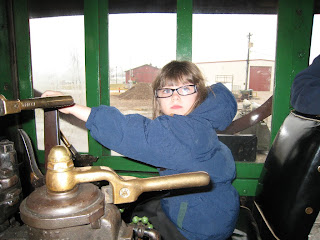
On Thursday, the day before the first NPE train, we began preparing the engine for use. The 9 had received a quick "rinse and blow dry" after the last Ghost Train which included removing most of the boiler plugs.
First order of business is replacing the plugs, topping the boiler with water, lighting a fire to warm the boiler, and a city-pressure hydrostatic check.
The 9 was a bit more finicky than usual. One boiler plug had a noticeable stream of water pouring -- and this was before we lit a fire! It was a pleasant surprise that loosening and re-tightening the plug was sufficient to seat it and stop the leak. Often, the plug requires removal which in turn releases the hundreds of gallons of water above it.
With the leak stopped, we tried to light a fire. The process includes running the gasoline air compressor (its battery was dead and then it wouldn't idle), hooking it to the locomotive (the "chicago" style claw fitting failed), and lighting a spray of oil from the burner head (it wouldn't light). Usually, a waste oil soaked rag will light on fire, get tossed into the firebox, and the fine spray of fuel oil will burst into a controlled fire over the rag. This time, nothing. In fact, the "fine spray of fuel oil" actually put out the fire on the waste oil soaked burning rag. Apparently the fuel oil was contaminated with water or some other nonflammable fluid and nothing would get the oil burning. The only path was to remove the contaminated fuel and replace it with fresh fuel from the oil bunker. Only, since it was already late Thursday evening, we decided to wait until Friday morning for fuel swap.
Friday, the day of the first train, started with pumping the contaminated oil into "totes" and adding fresh fuel. After a hundred or so gallons of fuel was added, the fire lit in seconds and we were on our way to heating the water for the hydrostatic check.
The next few pictures show the 9 warming near the fuel bunker and engineer intern Abe C watching the fuel filler hose while standing on the 9's oil tank.



An outside, closeup view of the fire raging inside the 9's firebox.

The warm-up, complete fill up, and pressure test of the 9 went picture perfect. We had the locomotive ready long before the first NPE train which gave us time to do a few light laps. Since this was the first day, the staff at the "North Pole" didn't realize we need ample clearance to get the engine past the parked cars.
Here, the 9 awaits the driver to move their car from in front of the North Pole (a.k.a the south station).

It was a coldish day, so the various places for leaking or venting steam become real obvious as the locomotive passes.


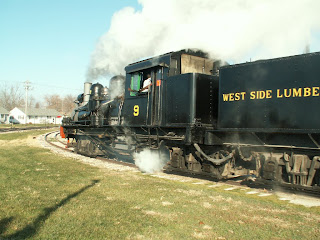


Friday night's NPE trains went story book perfect.
The staff got up early on Saturday to ready the locomotive for second day of the event. Since the engine was still hot from the previous night's use, the gasoline air compressor was not needed to start the fire. We prefer to start it on residual steam, mainly due to the silence of not having the gasoline compressor roaring.
After hooking to the engine to the train, the cab crew pulled the train to the north station for the first load of riders.
A cab crew member visually checks the steam cylinders while waiting at the station.

The train passes the outside of the south station on its way north.

The brakeman and his assistant stand on the rear platform of the caboose.

Something odd occurred while awaiting the riders to re-board the 1 PM train. It wasn't apparent as the engine idled outside the south station, but became obvious when we pulled away. As steam was being drawn off the boiler to move the locomotive, the quantity of draft available to keep that head of steam went away -- exactly the opposite of what one would expect. The fire just sounded weird.
At the north station, once again, the fire was well behaved while at the station, but backward while the engine was moving. After dropping the 3 PM train at the North Pole, the 9 was moved to the shop to determine the cause of the problem. The suspicions were limited to escaping steam in the smokebox, but the source of the leak was undetermined.
Three teams started working at the challenge at hand.
Team 1 was debugging the 9. Where was the leak, what caused it, and how will it be fixed?
Team 2 was tasked with readying the 6 for service. The North Pole Express looks best when pulled by steam and we were all curious if the 6 could deal with the longer, heavier, trains on slippery tracks. Unlike the 9, the 6 was completely "pickled" for the season, so a major amount of labor went into plugging the boiler, replacing check valves, and undoing anything that was done after the last Ghost Train. Even the burner was swapped out for a more robust burner, capable of burning more fuel (and much thicker fuel).
Team 3 was tasked with running the Plymouth Diesel 14 to move steam engines about and pull the NPE trains.
Dustin B and Griffin W make a new gasket to replace one that had to be removed while searching for the source of the steam leak.
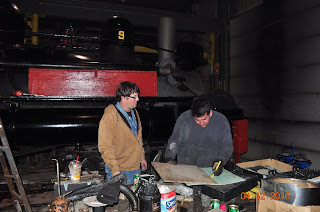
Jesse V and Dustin B contemplate crawling into the smoke box to continue the leak investigation.

Griffin W was selected to do the dirty work: climb into the smokebox and remove a series of superheaters to pinpoint the leak.

While the 9 was being debugged, the 6 was warming up for its pressure test.
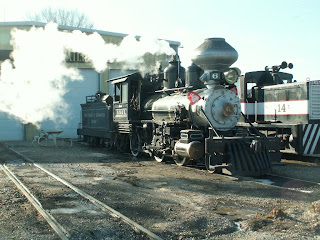
The crew of the diesel 14 pulled the 3 PM train out of the North Pole, pulled the complete 5 PM train, and pulled the 7 PM train into the North pole. By 8 PM, about 30 minutes before the 7 PM train was to be removed from the North Pole, the 6 was doing light laps to prepare itself for the night's finale. The 6 was attached to the passenger cars waiting inside the North Pole and easily pulled the train back to the north station.
Meanwhile, "team 1" had determined that a manifold-to-superheater joint had failed. When the throttle was opened so much steam was venting into the firebox that the expected draft was snuffed out causing the firing problems experienced earlier that day. Griffin worked through the night to repair the superheater joints and the 9 was ready to fire Sunday morning.
The staff decided to give the 6 a good test on Sunday. In general, the 9 pulled the majority of trains letting the 6 do the others. Both engines worked wonderfully, despite the cold and mild winter-like track conditions.
The second weekend of NPE had the benefit of additional snow over what was on the ground from the previous week. We prefer more snow (not too much!) as it gives a better show to the riders awaiting the train's arrival at the north station.
Here, the 9 does some light laps to test its repair before picking up the passenger cars.

The 9 does a boiler blowdown at the northwest corner.

The 9 pulls past the switch tower, located just east of the north station.

The 9 chugs past the North Pole on its way north.

A low-flying bird's eye view of the 9 at the switch tower.

Another light lap for the 9.


The second weekend's Sunday was brutal: extreme cold and blowing snow.
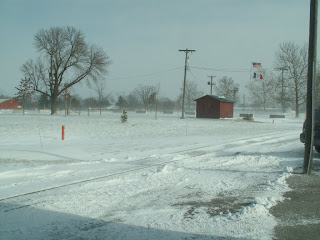
The 9 is traveling south along the east side of the park. Notice how the steam is tracking in front of the engine?
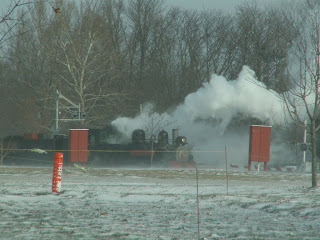

Getting close to the North Pole.

Passing outside the North Pole.
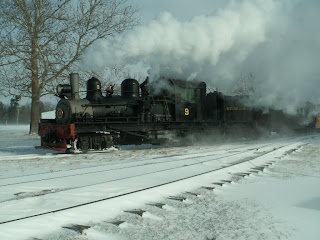

Monday after the last NPE day was full boiler washing for the 9. The 9 is parked along the west side with its blowoff valve open to drain the water. The water wasn't at boiling, but with the outside temperature so low, it vigorously steamed.
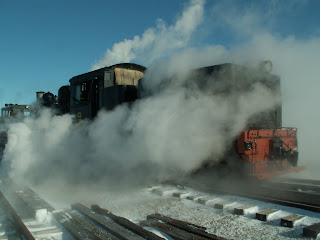

After draining the water, the engine gets moved back and forth under compressed air to remove bits of condensed water from the steam lines and cylinders.

Someone caught Fireman Elliot H at his perch near the boiler controls during the first NPE weekend.

Although not caught in the act, the oil valve handle was converted into a Shay serpent.

This entry gives the same story from the operations standpoint, and more to the point, from the locomotive and shop crew's standpoint.
Before getting into the details of what is done to service the trains and riders of NPE, we do take time to have a bit of fun. Here, Katie B gets a chance to run the 9. She is a bit heavy on the throttle but we think she will work out well. Now, if she could only see over the mechanical steam cylinder lubricator...

On Thursday, the day before the first NPE train, we began preparing the engine for use. The 9 had received a quick "rinse and blow dry" after the last Ghost Train which included removing most of the boiler plugs.
First order of business is replacing the plugs, topping the boiler with water, lighting a fire to warm the boiler, and a city-pressure hydrostatic check.
The 9 was a bit more finicky than usual. One boiler plug had a noticeable stream of water pouring -- and this was before we lit a fire! It was a pleasant surprise that loosening and re-tightening the plug was sufficient to seat it and stop the leak. Often, the plug requires removal which in turn releases the hundreds of gallons of water above it.
With the leak stopped, we tried to light a fire. The process includes running the gasoline air compressor (its battery was dead and then it wouldn't idle), hooking it to the locomotive (the "chicago" style claw fitting failed), and lighting a spray of oil from the burner head (it wouldn't light). Usually, a waste oil soaked rag will light on fire, get tossed into the firebox, and the fine spray of fuel oil will burst into a controlled fire over the rag. This time, nothing. In fact, the "fine spray of fuel oil" actually put out the fire on the waste oil soaked burning rag. Apparently the fuel oil was contaminated with water or some other nonflammable fluid and nothing would get the oil burning. The only path was to remove the contaminated fuel and replace it with fresh fuel from the oil bunker. Only, since it was already late Thursday evening, we decided to wait until Friday morning for fuel swap.
Friday, the day of the first train, started with pumping the contaminated oil into "totes" and adding fresh fuel. After a hundred or so gallons of fuel was added, the fire lit in seconds and we were on our way to heating the water for the hydrostatic check.
The next few pictures show the 9 warming near the fuel bunker and engineer intern Abe C watching the fuel filler hose while standing on the 9's oil tank.



An outside, closeup view of the fire raging inside the 9's firebox.

The warm-up, complete fill up, and pressure test of the 9 went picture perfect. We had the locomotive ready long before the first NPE train which gave us time to do a few light laps. Since this was the first day, the staff at the "North Pole" didn't realize we need ample clearance to get the engine past the parked cars.
Here, the 9 awaits the driver to move their car from in front of the North Pole (a.k.a the south station).

It was a coldish day, so the various places for leaking or venting steam become real obvious as the locomotive passes.





Friday night's NPE trains went story book perfect.
The staff got up early on Saturday to ready the locomotive for second day of the event. Since the engine was still hot from the previous night's use, the gasoline air compressor was not needed to start the fire. We prefer to start it on residual steam, mainly due to the silence of not having the gasoline compressor roaring.
After hooking to the engine to the train, the cab crew pulled the train to the north station for the first load of riders.
A cab crew member visually checks the steam cylinders while waiting at the station.

The train passes the outside of the south station on its way north.

The brakeman and his assistant stand on the rear platform of the caboose.

Something odd occurred while awaiting the riders to re-board the 1 PM train. It wasn't apparent as the engine idled outside the south station, but became obvious when we pulled away. As steam was being drawn off the boiler to move the locomotive, the quantity of draft available to keep that head of steam went away -- exactly the opposite of what one would expect. The fire just sounded weird.
At the north station, once again, the fire was well behaved while at the station, but backward while the engine was moving. After dropping the 3 PM train at the North Pole, the 9 was moved to the shop to determine the cause of the problem. The suspicions were limited to escaping steam in the smokebox, but the source of the leak was undetermined.
Three teams started working at the challenge at hand.
Team 1 was debugging the 9. Where was the leak, what caused it, and how will it be fixed?
Team 2 was tasked with readying the 6 for service. The North Pole Express looks best when pulled by steam and we were all curious if the 6 could deal with the longer, heavier, trains on slippery tracks. Unlike the 9, the 6 was completely "pickled" for the season, so a major amount of labor went into plugging the boiler, replacing check valves, and undoing anything that was done after the last Ghost Train. Even the burner was swapped out for a more robust burner, capable of burning more fuel (and much thicker fuel).
Team 3 was tasked with running the Plymouth Diesel 14 to move steam engines about and pull the NPE trains.
Dustin B and Griffin W make a new gasket to replace one that had to be removed while searching for the source of the steam leak.

Jesse V and Dustin B contemplate crawling into the smoke box to continue the leak investigation.

Griffin W was selected to do the dirty work: climb into the smokebox and remove a series of superheaters to pinpoint the leak.

While the 9 was being debugged, the 6 was warming up for its pressure test.

The crew of the diesel 14 pulled the 3 PM train out of the North Pole, pulled the complete 5 PM train, and pulled the 7 PM train into the North pole. By 8 PM, about 30 minutes before the 7 PM train was to be removed from the North Pole, the 6 was doing light laps to prepare itself for the night's finale. The 6 was attached to the passenger cars waiting inside the North Pole and easily pulled the train back to the north station.
Meanwhile, "team 1" had determined that a manifold-to-superheater joint had failed. When the throttle was opened so much steam was venting into the firebox that the expected draft was snuffed out causing the firing problems experienced earlier that day. Griffin worked through the night to repair the superheater joints and the 9 was ready to fire Sunday morning.
The staff decided to give the 6 a good test on Sunday. In general, the 9 pulled the majority of trains letting the 6 do the others. Both engines worked wonderfully, despite the cold and mild winter-like track conditions.
The second weekend of NPE had the benefit of additional snow over what was on the ground from the previous week. We prefer more snow (not too much!) as it gives a better show to the riders awaiting the train's arrival at the north station.
Here, the 9 does some light laps to test its repair before picking up the passenger cars.

The 9 does a boiler blowdown at the northwest corner.

The 9 pulls past the switch tower, located just east of the north station.

The 9 chugs past the North Pole on its way north.

A low-flying bird's eye view of the 9 at the switch tower.

Another light lap for the 9.


The second weekend's Sunday was brutal: extreme cold and blowing snow.

The 9 is traveling south along the east side of the park. Notice how the steam is tracking in front of the engine?


Getting close to the North Pole.

Passing outside the North Pole.


Monday after the last NPE day was full boiler washing for the 9. The 9 is parked along the west side with its blowoff valve open to drain the water. The water wasn't at boiling, but with the outside temperature so low, it vigorously steamed.


After draining the water, the engine gets moved back and forth under compressed air to remove bits of condensed water from the steam lines and cylinders.

Someone caught Fireman Elliot H at his perch near the boiler controls during the first NPE weekend.

Although not caught in the act, the oil valve handle was converted into a Shay serpent.

-steam.airman
Monday, January 17, 2011
Scenes from the 2010 North Pole Express
Every year, the MCRR hosts the "North Pole Express." If you are curious what happens during this event, the following should give you a good idea of what our visitors experience.
After parking their cars at the north end of McMillan Park, North Pole Express riders walk towards the North Station.

Rather than mailing tickets to the riders, they check in with our staff (Jeanie T. shown here awaiting the next customer) and learn of their passenger car for their trip to the "North Pole."

As the upcoming train's riders start to gather at the North Station, in the distance they hear the rumble from one of several steam or diesel locomotives owned and operated by the MCRR.
For 2010, the 9 (three truck Class C Shay), the 6 (2-6-0 Baldwin), and 14 (0-4-0 diesel Plymouth Locomotive Works) all participated in the NPE trains. 66% of the trains were pulled by the 9, 23% were pulled by the 6, and 11% were pulled by the 14. In a perfect world, all the trains would be pulled by one locomotive, but numerous challenges kept one engine from dominating the action.
Most riders witnessed this scene -- the 9 chugging up the hill with its train ready to take riders to the "North Pole."

This is the view from the fireman's side of the locomotive as it approaches the North Station.


A few stragglers await companions before they board the train.

The train crew chat amongst themselves awaiting the last few passengers to board.

The train circles the park at least 1.5 times before pulling into the "North Pole" (usually known as the South Station.).
One of the first sights seen by passengers as then disembark is the snow princess.
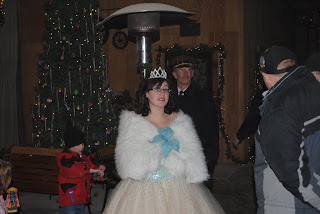
Santa awaits the children in the caboose.
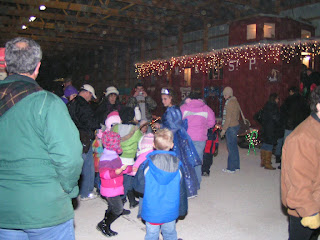


Santa having his picture taken by a proud parent.

Leaving the Santa caboose.

It is the "North Pole" and despite the infrared heaters, it does get a bit cold. Hot chocolate, coffee, and cookies are available for the participants.

Standing in front of a baggage cart loaded with presents, a young rider has a big smile as her parents take a picture.


The North Pole has a crafts room where children can make paper ornaments and other items.

A well stocked, railroad oriented gift shop is available.

After parking their cars at the north end of McMillan Park, North Pole Express riders walk towards the North Station.

Rather than mailing tickets to the riders, they check in with our staff (Jeanie T. shown here awaiting the next customer) and learn of their passenger car for their trip to the "North Pole."

As the upcoming train's riders start to gather at the North Station, in the distance they hear the rumble from one of several steam or diesel locomotives owned and operated by the MCRR.
For 2010, the 9 (three truck Class C Shay), the 6 (2-6-0 Baldwin), and 14 (0-4-0 diesel Plymouth Locomotive Works) all participated in the NPE trains. 66% of the trains were pulled by the 9, 23% were pulled by the 6, and 11% were pulled by the 14. In a perfect world, all the trains would be pulled by one locomotive, but numerous challenges kept one engine from dominating the action.
Most riders witnessed this scene -- the 9 chugging up the hill with its train ready to take riders to the "North Pole."

This is the view from the fireman's side of the locomotive as it approaches the North Station.


A few stragglers await companions before they board the train.

The train crew chat amongst themselves awaiting the last few passengers to board.

The train circles the park at least 1.5 times before pulling into the "North Pole" (usually known as the South Station.).
One of the first sights seen by passengers as then disembark is the snow princess.

Santa awaits the children in the caboose.



Santa having his picture taken by a proud parent.

Leaving the Santa caboose.

It is the "North Pole" and despite the infrared heaters, it does get a bit cold. Hot chocolate, coffee, and cookies are available for the participants.

Standing in front of a baggage cart loaded with presents, a young rider has a big smile as her parents take a picture.


The North Pole has a crafts room where children can make paper ornaments and other items.

A well stocked, railroad oriented gift shop is available.

-steam.airman
Subscribe to:
Posts (Atom)